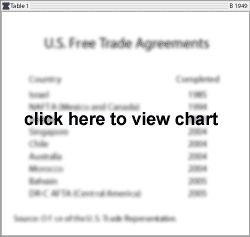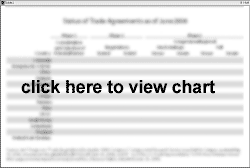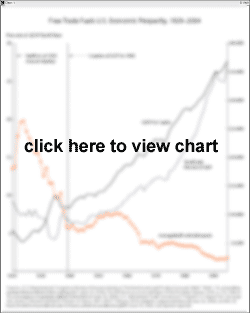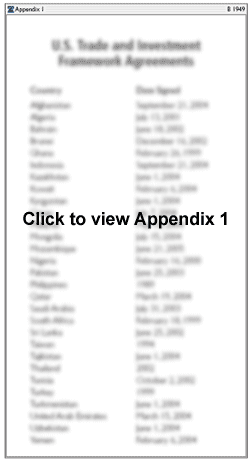America's Free Trade Agenda
The U.S. has forged a strong leadership role within the WTO. With 149 members in the WTO, the United States benefits from the increased market access generated by multilateral trade agreements.
Along with multilateral trade liberalization in the WTO, regional and bilateral FTAs also figure as important U.S. trade policy tools.[1] The U.S. has been seeking comprehensive and high-quality trade agreements that are "tailored to reflect a world of high technology, complex new intellectual property standards, labor and environmental considerations, and the growth of the service sector."[2]
While multilateral negotiations take time, FTAs allow the U.S. the option of obtaining agreements with countries that are willing to dismantle foreign trade barriers rapidly. FTAs formed with different countries or regions can also serve as building blocks for broader agreements and provide institutional competition that helps to keep multilateral talks on track.
Existing FTAs
As of May 2006, the U.S. has nine FTAs with 15 countries. (See Table 1.) Congress has approved the trade pacts with Israel, Canada and Mexico,[3] Jordan, Singapore, Chile, Australia, Bahrain, and Morocco. Most recently, it approved DR–CAFTA, the Dominican Republic–Central America Free Trade Agreement, which includes the Dominican Republic, Costa Rica, El Salvador, Guatemala, Honduras, and Nicaragua.
These nine FTAs have been producing impressive results. They account for more than $900 billion in two-way trade, which is about 36 percent of total U.S. trade with the world. U.S. exports to FTA partner countries are growing twice as fast as U.S. exports to countries that do not have FTAs with the U.S.[4]
Trade promotion authority (TPA), formerly known as fast track authority, has helped the U.S. negotiate and conclude new free trade agreements in an efficient and timely manner. Under TPA, Congress can approve or reject an entire agreement, but it cannot alter specific provisions in the agreement. In return, the President must fulfill certain criteria in each FTA, as specified by Congress.
Because of the way that TPA is implemented, countries are assured that U.S. trade policy commitments in an FTA will not be amended by Congress after negotiations are concluded. Consequently, TPA enhances America's ability to negotiate trade agreements by ensuring that U.S. commitments are made in good faith. This minimizes the cost and uncertainty associated with the negotiation process. The current TPA will expire on July 1, 2007.
The FTA Process
Although TPA legislation defines several objectives that affect the structure and content of an FTA, it does not limit the list of potential FTA partners by any criteria other than the degree to which a country has put into practice its existing WTO obligations.[5] Accordingly, there are three main stages of the FTA process.
Phase I: Consideration and Selection of an FTA Partner
Economic and political factors play a role in determining a country's appeal as a U.S. FTA partner. A 2004 General Accounting Office study reported that the process of assessing potential FTA partners is based on six criteria:
A country's readiness in terms of its trade capabilities, the maturity of its political and legal systems, and its will to implement economic reforms;
The economic benefit to the U.S.;
The country's support of U.S. goals in liberalizing trade;
The country's support of U.S. foreign and economic policy interests;
Congressional or private-sector support; and
Constraints on U.S. government resources.[6]
Phase II: Negotiations
Once the Administration decides to pursue a trade deal, it must notify Congress at least 90 days before launching official negotiations. Relevant congressional committees and the congressional oversight group must be consulted about the possible FTA before and after the notice. According to TPA guidelines, the Administration is then required to consult with Congress throughout the negotiating process. Negotiations are conducted by the U.S. Trade Representative.
Phase III: Congressional Approval and Implementation
After an agreement is concluded, the final language of the bill implementing the FTA is shaped by "mock" or "nonmark" markups in Congress.[7] House and Senate committees work informally on a draft bill that is then passed on to the President. The Administration uses this draft as a basis for its formal submission for congressional consideration, and Congress agrees to take a straight up-or-down vote on the proposed trade agreement.
Currently, the U.S. is in various stages of FTA negotiations or implementation with nine other countries and regions. (See Table 2.)
Status of U.S. FTAs
Currently, three FTAs are awaiting congressional approval and implementation, seven are in negotiation, and five more are in the first phase of selection. These are summarized in Table 2.
Phase I: Consideration and Selection of an FTA Partner
Enterprisefor ASEAN.[8] This initiative, introduced by President George W. Bush in October 2002, offers incentives for launching bilateral FTAs with individual countries of the Association of South East Asian Nations (ASEAN). The negotiation of a region-wide Trade and Investment Framework Agreement is viewed as the first step.
Middle EastFree Trade Agreement Initiative. The President announced this initiative in May 2003. The goal is to create a U.S.–Middle East Free Trade Agreement by 2013.
New Zealand. To support the launch of FTA negotiations with New Zealand, 54 members of the House created the Friends of New Zealand Congressional Caucus in February 2005.
Switzerland. The U.S. and Switzerland signed the Trade and Investment Cooperation Forum agreement on May 25, 2006.
Phase II: Negotiations
Free Trade Area of the Americas (FTAA).[9] The FTAA was promoted by President Ronald Reagan and President George H. W. Bush through the Enterprise for the Americas Initiative. The trade pact was formally launched by President Bill Clinton in 1994. At the Third Summit of the Americas in Quebec in 2001, steps were made toward detailed, substantive, and concrete negotiations on the FTAA. At the 2005 Summit of the Americas in Argentina, the majority of hemispheric leaders reaffirmed their commitment to move forward on the FTAA.
Malaysia. Congress was notified in March 2006. The first round of negotiations started on June 11, 2006.
Panama. Congress was notified in November 2003. The first round of negotiations started in April 2004.
Southern African Customs Union (SACU).[10] Congress was notified in November 2002. Formal negotiations started in June 2003. In April 2006, the U.S. and SACU countries opted to pursue freer trade through a trade investment cooperation agreement (TICA) rather than through a comprehensive FTA. The TICA establishes a working group to address issues in customs, trade facilitation, intellectual property, and other areas typically included in an FTA. Once the largest concerns are rectified within the TICA, the potential for successfully concluding an FTA should be greater.
South Korea. Congress was notified in February 2006. The first round of negotiations started on June 5, 2006.
Thailand. Congress was notified in February 2004. Formal negotiations started in June 2004. Currently, negotiations are halted due to political turmoil in Thailand.
United Arab Emirates. Congress was notified in November 2004. The first round of negotiations started in March 2005.
Phase III: Congressional Approval and Implementation
Colombia.[11] The Administration initiated FTA negotiations in May 2004. An agreement was concluded in February 2006.
Oman. FTA negotiations were concluded in October 2005. The House Ways and Means Committee voted in favor of the trade pact on May 10, 2006. The Senate Finance Committee approved the agreement with Oman on June 28, 2006.
Peru. The Administration initiated FTA negotiations in May 2004. An agreement was concluded in December 2005. Following a change in governments, Peru has indicated that it may wish to renegotiate the FTA.
Some FTA negotiations fail and have to be restarted. It is hoped that all of the current FTAs in process will reach full implementation. It is worth noting that at least one recent proposed FTA has already been cancelled. Official FTA negotiations with Ecuador began in 2004, but the negotiations with Ecuador were cancelled due to Ecuador's decision to cancel the oil operation contract of U.S.-based Occidental Petroleum Corporation.
Other Trade-Facilitating Agreements
For countries that are unable to pursue a comprehensive FTA with the U.S., the U.S. has more generalized policy tools to facilitate trade and resolve bilateral trade and investment issues. A trade and investment framework agreement aims to enhance trade and investment relations as well as to provide consultative mechanisms to discuss outstanding issues. The U.S. has pursued TIFAs with countries that have worked to open their markets and move toward market liberalization.[12] Similarly, a bilateral investment treaty (BIT) aims to protect U.S. investment interests in foreign countries and promotes more market-oriented polices.[13]
These two types of agreements often play important roles in building up the necessary economic and political institutions and infrastructure in a partner country, promoting the viability of an FTA with the U.S. in the future. The appendices summarize the TIFAs and BITs that the U.S. has signed.
In addition to these two trade and investment policy tools, the U.S. offers partner countries bilateral market access agreements. As part of the WTO accession process, countries interested in joining the WTO are required to have bilateral trade talks with any interested WTO member country. These bilateral trade and investment talks typically cover tariff rates, specific market access commitments, and other policies in goods and services.
The U.S. has recently concluded and signed a bilateral market access agreement with Vietnam. The agreement is an important step forward in normalizing bilateral relations and is required for Vietnam's accession to the WTO. For the agreement to take effect, Congress must approve permanent normal trade relations (PNTR) status for Vietnam, authorizing trade advantages that the United States grants to most countries. To authorize PNTR, Congress must exempt Vietnam from application of the Jackson–Vanik Amendment to the Trade Act of 1974.[14]
Remembering the Positive Experience of Free Trade
Free and open trade has contributed to the enormous prosperity that America enjoys today, and the U.S. has historically been a bastion of free trade rules. Lower trade barriers allow America's households and businesses to spend less on a wider variety of goods and make U.S. exports more competitive in world markets.
For over five decades, the U.S. has benefited from reducing its trade barriers even further, paving the way for substantial economic expansion and increased living standards globally. As shown in Chart 1:
The average U.S. tariff rate on all goods has fallen from over 19 percent in 1933 to 1.8 percent in 2004.
As a percentage of gross domestic product (GDP), the importance of trade in the economy has climbed from single digits in the 1930s to nearly one-quarter of GDP in 2004.
While trade has become freer, real per capita GDP in the U.S. has climbed from a low of $5,061 in 1933 to about $36,000 in 2004 (in constant 2000 dollars).
Continued American leadership depends not only on U.S. trade negotiators' intensive efforts, but also on congressional support for free trade. Domestic priorities—such as fostering U.S. economic growth and job creation, opening foreign markets to American farmers and manufacturers, and increasing living standards—fully mesh with negotiators' efforts to promote trade liberalization.
The American economy depends on international trade. The successful conclusion of negotiations and swift congressional implementation of beneficial free trade agreements will enable America to build an even brighter future.
Anthony Kim is Research Data Specialist and Daniella Markheim is Jay Van Andel Senior Trade Policy Analyst in the Center for International Trade and Economics at The Heritage Foundation.






